
Our grapes have now been harvested, and all ladies and gentlemen that have been handling them are back in their normal lifes. The impressions from the vendange of our remote corner of the Côte de Blancs are:
The grapes have been very impressive. Hardly any rot or other disease, and that goes for both the white Chardonnay and the red Pinot Meunier. However, we have heard rumours that there will be a lack of reds this year, due to severe attacks of the disease mildew and botrytis in other areas of Champagne.
On top of that the grapes have been exceptionally big. Around 15 percent on top of the normal weight, which all the workers in the vineyard have felt. The fatigue the last day was just bigger than normal because all grapes, baskets and boxes were more heavy than normal.
The weather in September has been magnificent. An Indian Summer in the first half of the month matured the grapes very fast. Unfortunately it also made the botrytis spread very fast and so much (according to the CIVC-measurements) that we got a bit nervous whether our startdate was too late. However it turned out there was no need to worry, since the temperatures just a few day before D-day almost halved from one day to the next which stopped the development of the fungus. Our Pinot Meunier were in general fine, though not as exceptionnal as the Chardonnay.
The weather for the vendange was close to perfect. A bit cool in the early morning with temperatures that climbed into the single digits but dry. A few hours later however the sunshine was warm enough to heat up the rows pleasantly. Only the last couple of days the afternoons were getting a bit too warm with temperatures passing 20 degrees Celsius. After all picking the grapes is a pretty physical job.
During the seven days we have picked close to 50.000 kilo white Chardonnay and red Pinot Meunier spaced on three different plots in the villages Soulières and Loisy-en-Brie and send them to the press at the cooperative Eustache Deschamps in Vertus. This means that every worker has send close to five tons of grapes into their baskets during the seven days of the vendange.
At the cooperative the staff has worked almost around the clock in order to follow the supplies. Only four hours of sleep they have had during the 10 days of the vendange. Several of the members have delivered their quota of grapes more than double as fast as normal, since the big grapes of the year has made it so easy to fill up the baskets and boxes. The cooperative however has had problems to cope.
We weighed the biggest grapes that we found to around 600 g for a Chardonnay-grape and around 560 for a Pinot Meunier-grape. They all ended up most deliciously in a clafoutis. We will all remember 2005 as the year of the extremely big grapes and the lacking boxes. They seemed stuck in lines at the coop pretty regular for the above mentioned reasons.

And this is what they looked like: Pinot Meunier

and Chardonnay. Really nice and hardly any disease at all.

The 10 pickers work with either bended backs or knees.

They work in teams of two, one on each side of a row.

The grapes are put in a basket, that is emptied in big 50 kg boxes, driven through the rows on caterpillars.
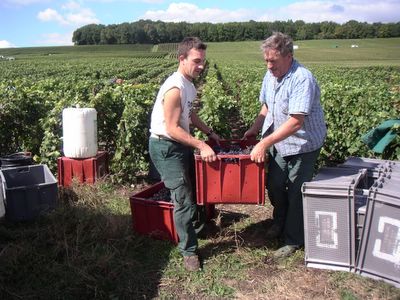
The vendange of 2005 has featured 15 procent more lifts than normal because of the big grapes.

The truck of Gérard contains about one fifth of a days work, that is two pallets or around 1200 kg of grapes.

Queing up at the coop where more than 200 members deliver their production.

The grapes are weighed and registered.

8000 kg of grapes ready for the press: A marc.
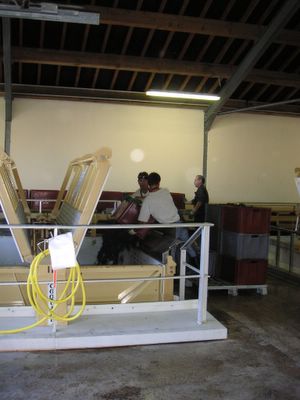
The grapes are transported on pallets and poured into the press manually.

Chardonnay is distributed in one of the five presses.

The cover of the press clicks. The proces lasts four hours.

New must from the grapes. The big vessel is for la cuvée (what comes out of the first part of the pressing which is around 4100 litres), the small vessel is for la taille (what comes out of the second part of the pressing which is around 1000 litres). Only la cuvée is used for champagne.
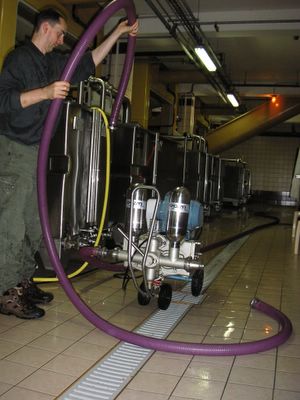
In the basement under the presses the must is tapped from the vessels connected with the presses to tall tanks covered with tiles.
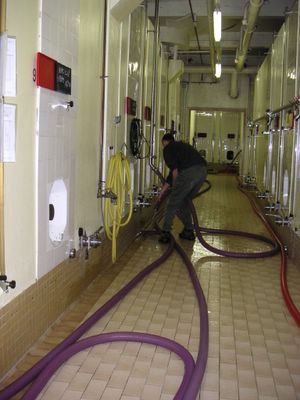
The must stays in the tiled tanks in 24 hours. During this period the biggest impurities will sink to the bottom.
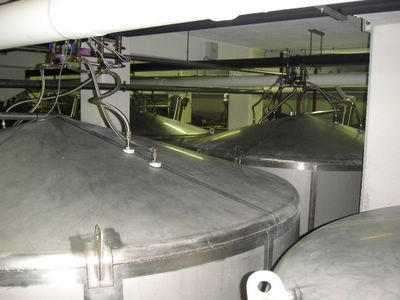
After this first cleaning the must is pumped into big steeltanks where it fermentates the first time. After seven days the must has been transformed to still wine. However there is quite some time and work to go before it becomes champagne.
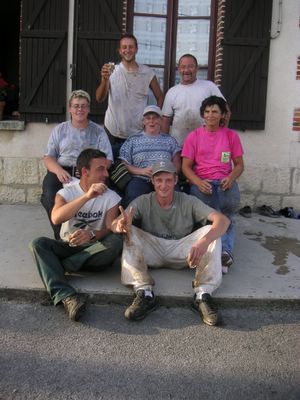
Skål, santé... and see you around in 2006.
På dansk



















No comments:
Post a Comment